Practice Exercises - Heredity - AP Biology Premium 2024
Practice Questions
Multiple-Choice
1. Which of the following correctly describes the products of meiosis?
(A) two genetically identical diploid cells
(B) two genetically different diploid cells
(C) four genetically identical haploid cells
(D) four genetically different haploid cells
2. An organism’s diploid number is 28. Which of the following is a correct statement about this organism?
(A) Its somatic cells would have 14 chromosomes, and its gametes would have 28 chromosomes.
(B) Its somatic cells would have 28 chromosomes, and its gametes would have 14 chromosomes.
(C) Both its somatic cells and its gametic cells would have 14 chromosomes.
(D) Both its somatic cells and its gametic cells would have 28 chromosomes.
3. Which of the following stages of meiosis generates genetic diversity?
(A) prophase I
(B) prophase II
(C) anaphase I
(D) anaphase II
4. Independent assortment of chromosomes occurs during which stage of meiosis?
(A) metaphase I
(B) metaphase II
(C) telophase I
(D) telophase II
5. Which of the following is a correct statement about meiosis?
(A) DNA replication occurs once, and there is one round of cell division.
(B) DNA replication occurs twice, and there is one round of cell division.
(C) DNA replication occurs once, and there are two rounds of cell division.
(D) DNA replication occurs twice, and there are two rounds of cell division.
6. How does the frequency of recombination events between genes that are close together on the same chromosome compare to the frequency of recombination events between genes that are far apart on the same chromosome?
(A) Genes that are close together on the same chromosome will recombine less frequently than genes that are far apart.
(B) Genes that are close together on the same chromosome will recombine more frequently than genes that are far apart.
(C) Genes that are close together on the same chromosome will recombine at the same rate as genes that are far apart.
(D) Genes that are on the same chromosome never have recombination events between them.
7. Which of the following statements correctly describes a difference between mitosis and meiosis?
(A) Mitosis produces four daughter cells, whereas meiosis produces two daughter cells.
(B) Mitosis produces genetically different cells, whereas meiosis produces genetically identical cells.
(C) Mitosis produces somatic cells, whereas meiosis produces gametes.
(D) Mitosis produces haploid cells, whereas meiosis produces diploid cells.
8. Aneuploidies can result from errors during which stage of meiosis?
(A) prophase I
(B) metaphase I
(C) anaphase I
(D) telophase I
Questions 9 and 10
The following figure is a karyotype, a picture that shows the chromosomes found in a somatic human cell.
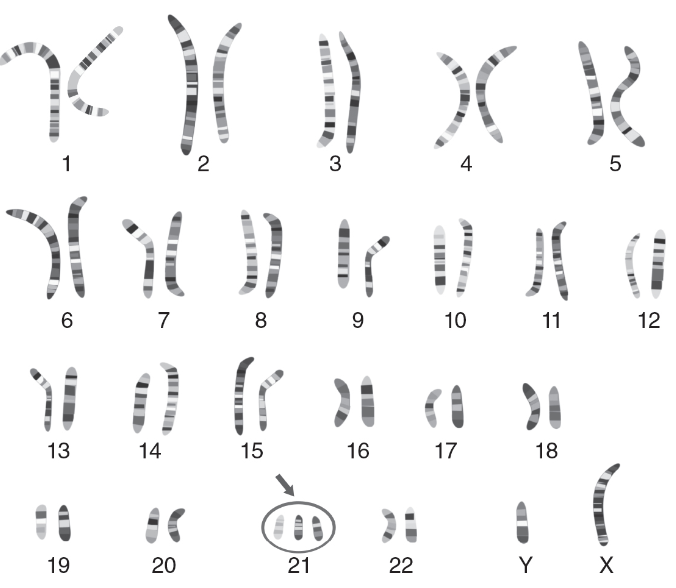
9. Which of the following best describes the condition shown in the circle?
(A) trisomy
(B) haploidy
(C) monosomy
(D) diploidy
10. Which of the following was the most likely cause of the condition shown in the circle?
(A) translocation
(B) independent assortment
(C) nondisjunction
(D) genetic recombination
Short Free-Response
11. Genes A, B, and C are on the same chromosome. The frequencies of genetic recombination events between the genes is shown in the following table.

(a) Using this data and the following template, construct a genetic map of these three genes.

(b) Explain your placement of the three genes on the genetic map from part (a).
(c) A new gene, D, is discovered on the same chromosome. A and D have a recombination frequency of 10%. B and D have a recombination frequency of 35%. On your genetic map from part (a), draw an additional line to represent the relative location of gene D on the chromosome.
(d) A different chromosome in the organism has genes, M, N, O, and P. One copy has the alleles MNOP. The other copy of the chromosome has the alleles mnop. If genetic recombination occurred between genes N and O, explain the two possible gametes that would be produced by this crossing-over event.
12. An organism has a diploid number of six chromosomes.
(a) Determine the number of chromosomes in each of the four cells that would be produced upon the completion of meiosis II.
(b) Based on your answer to part (a), explain why the cells would each have that number of chromosomes at the end of meiosis II.
(c) A nondisjunction event occurred during anaphase II. Predict the number of chromosomes that would be found in each of the four cells after this nondisjunction event.
(d) Justify your prediction from part (c).
Long Free-Response
13. An organism has the two chromosomes shown in the following figure.

A student claims that exposure to UV light prior to meiosis will increase the frequency of genetic recombination during meiosis. Gamete-producing cells from this organism are placed into two groups. One group is not exposed to UV light, and the other group is exposed to UV light prior to undergoing meiosis. The gametes produced at the end of meiosis and the frequencies of those gametes are shown in the following table.

(a) Identify and explain the stage of meiosis during which genetic recombination occurs.
(b) Identify the independent variable and the dependent variable in this experiment.
(c) Using the data, provide reasoning to support the student’s claim.
(d) The experiment is repeated with increased exposure to UV light (for the cells that were exposed to UV light). Predict how this change will affect the recombination frequencies. Justify your prediction.
Practice Questions
Multiple-Choice
1. Mendel’s law of independent assortment is a result of
(A) the random nature of fertilization of ova by sperm.
(B) the random way homologous chromosomes undergo genetic recombination in meiosis.
(C) the random way homologous chromosomes line up in metaphase I of meiosis.
(D) the random nature of molecular movement at high temperatures.
2. The term hybrid can also mean _________.
(A) homozygous
(B) heterozygous
(C) haploid
(D) diploid
3. In peas, round (R) peas are dominant and wrinkled (r) peas are recessive. A plant with an unknown genotype for this trait has round peas. Which of the following results of a test cross would support the hypothesis that the genotype of the plant with the round peas is heterozygous?
(A) 100% round offspring
(B) 75% round offspring and 25% wrinkled offspring
(C) 50% round offspring and 50% wrinkled offspring
(D) 100% wrinkled offspring
4. In pea plants, smooth (S) pods are dominant and constricted (s) pods are recessive. Which of the following is a correct statement?
(A) A genotype of SS would result in the constricted pod phenotype.
(B) A genotype of Ss would result in the constricted pod phenotype.
(C) Constricted pods would always be homozygous.
(D) Smooth pods would always be homozygous.
5. Round peas are dominant to wrinkled peas. Smooth pea pods are dominant to constricted pea pods. Two pea plants that are heterozygous for both traits are crossed, and 800 offspring are produced. How many of the offspring are expected to have round peas and constricted pods?
(A) 450
(B) 150
(C) 50
(D) 0
6. A pea plant that is heterozygous for round peas and heterozygous for smooth pods is crossed with a pea plant that is heterozygous for round peas and has constricted pods. What fraction of the offspring are expected to have round peas and constricted pods? (Remember that round peas are dominant to wrinkled peas, and smooth pods are dominant to constricted pods.)

7. In humans, the gene for polydactyly (extra fingers or toes) is dominant over the gene for the typical number of fingers and toes. If a person who is heterozygous for polydactyly has children with a person with the typical number of fingers and toes, what is the probability that their first child will have polydactyly?
(A) 100%
(B) 50%
(C) 25%
(D) 0%
8. In the cross AaBbCc × AaBbCc, what is the probability of producing an offspring with the AABBCc genotype?

Questions 9 and 10
Rh positive (R) is a trait that is dominant over Rh negative (r). A woman, who is Rh positive, has a son, who is Rh negative.
9. Which of the following is a true statement about the mother?
(A) She must have the rr genotype.
(B) She must have the RR genotype.
(C) She must be heterozygous for the trait.
(D) She must have the same genotype as her son.
10. Which of the following is a true statement about the father of the woman’s son?
(A) He must have the RR genotype.
(B) He must have the Rr genotype.
(C) He must have the rr genotype.
(D) He may have either the Rr or the rr genotype.
Short Free-Response
11. Sickle cell disease is an autosomal recessive disorder. Homozygous recessive individuals have red blood cells that can assume a sickle shape when oxygen levels are low. These sickled blood cells can cause blockages in blood vessels, leading to pain and possibly fatal complications. Heterozygous individuals do not suffer the pain or complications from sickle cell disease and are more resistant to malaria than individuals with two nonsickle alleles. The following figure shows the pattern of inheritance of sickle cell disease through three generations of a family. Squares indicate males, circles indicate females, and shaded shapes indicate individuals who have sickle cell disease.
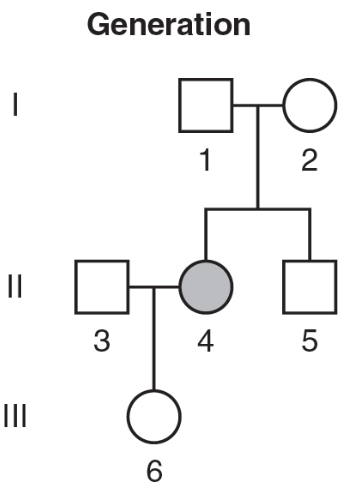
(a) Describe the genotype of individual I-2. Justify your answer with evidence from the pedigree.
(b) What is the genotype of individual III-6? Explain how you know her genotype.
(c) Create a Punnett square that represents the possible genotypes of the offspring of individuals 1 and 2 from generation I.
(d) Explain which genotype from this pedigree would provide an advantage in San Francisco (where the mosquito that carries malaria does not live) and which genotype would be most advantageous to survival in Haiti (where the mosquito that carries malaria is found).
12. Fur color in hamsters is determined by a single gene, with yellow fur color being dominant to white fur color. Inheriting two copies of the allele for yellow fur color is fatal, so all individuals with yellow fur are heterozygous.
(a) Determine the probability that the offspring of two hamsters with yellow fur would also have yellow fur.
(b) Construct a Punnett square that represents the two hamster parents from part (a), and use the Punnett square to explain your answer to part (a).
(c) A hamster population lives in an area covered with yellow-goldenrod-colored grasses. An unusually cold winter results in the death of all the yellow-goldenrod-colored grasses, so in the spring the area is covered only in white sand. Predict what would happen to the frequency of the allele for yellow fur color over time.
(d) Justify your prediction from part (c).
Long Free-Response
13. In pea plants, tall plant height is dominant over short. A new type of plant food (Supersize Food) is advertised to increase plant height. Two pea plants that are heterozygous for plant height are crossed, and the seeds that are produced are harvested. Half of the seeds are planted and grown in the presence of Supersize Food, and the other half of the seeds are planted and grown without Supersize Food. When the plants reach full maturity, the number of tall and short plants are recorded. The data are shown in the table.
 (a) Describe the proportions of tall and short plants that were expected to result from the cross. Use a Punnett square to support your answer.
(a) Describe the proportions of tall and short plants that were expected to result from the cross. Use a Punnett square to support your answer.
(b) Identify the independent variable and the dependent variable in this experiment. Identify one possible appropriate experimental constant.
(c) A student makes the claim that “there is no statistically significant difference between the plants grown in the presence or absence of Supersize Food.” Use the chi-square equation to analyze the data and evaluate this claim. Use a p-value of 0.05 for your analysis.
(d) A tall plant with an unknown genotype is crossed with a short plant. Predict the expected proportions of tall and short offspring if the tall plant is heterozygous. Justify your prediction.
Practice Questions
Multiple-Choice
1. Two genes that are close together on the same chromosome are said to be _______ and are _______ likely to be inherited together than _______ genes.
(A) linked; less; unlinked
(B) linked; more; unlinked
(C) unlinked; less; linked
(D) unlinked; more; linked
2. Sex-linked recessive traits in humans are _______ likely to be expressed in _______.
(A) less; males
(B) more; females
(C) more; males
(D) equally; both males and females
3. An example of a trait that involves multiple gene inheritance in plants is seed size. If seed size involves three genes (A, B, and C), in which each dominant allele contributes to increased seed size, which of the following genotypes would result in the smallest seed?
(A) AABBCC
(B) AaBBCc
(C) AaBbCC
(D) AaBbCc
4. Which of the following statements best explains the difference between nonnuclear inheritance and sex-linked inheritance?
(A) Females may pass on nonnuclear and sex-linked traits to both their sons and daughters, but only their sons may pass on nonnuclear traits to the next generation.
(B) Females may pass on nonnuclear and sex-linked traits to both their sons and daughters, but only their daughters may pass on nonnuclear traits to the next generation.
(C) Females may pass on sex-linked traits to their offspring, but they cannot pass on nonnuclear traits to their offspring.
(D) Females may pass on nonnuclear traits to their offspring, but they cannot pass on sex-linked traits to their offspring.
5. Two snowshoe hares (a type of rabbit) have the same genotype. During the winter, the hare that lives outdoors in the cold has white fur, but the hare that lives in a climate-controlled and warm environment has brown fur. This is an example of _______.
(A) sex-linkage
(B) multiple gene inheritance
(C) nonnuclear inheritance
(D) phenotypic plasticity
6. In Drosophila (fruit flies), females have two XX chromosomes, and males have one X chromosome and one Y chromosome. The eye color gene is located on the X chromosome, and the red-eyed allele is dominant to the white-eyed allele. A heterozygous, red-eyed female is mated with a white-eyed male. Which of the following is the most likely result in their offspring?
(A) All females are red-eyed, and all males are white-eyed.
(B) All females are red-eyed, 50% of males are red-eyed, and 50% of males are white-eyed.
(C) 50% of females are red-eyed, 50% of females are white-eyed, and all males are white-eyed.
(D) 50% of both sexes are red-eyed, and 50% of both sexes are white-eyed.
7. Sex determination in birds follows the ZW system, where males have two copies of the Z chromosome (ZZ) and females are heterozygous (ZW). A male bird (who is heterozygous for a trait on the Z chromosome) is mated with a female bird (who expresses the recessive phenotype for that trait). Which of the following best describes their most likely offspring?
(A) 25% males with the dominant phenotype, 25% males with the recessive phenotype, 25% females with the dominant phenotype, and 25% females with the recessive phenotype
(B) all males with the dominant phenotype and all females with the recessive phenotype
(C) 25% males with the dominant phenotype, 25% males with the recessive phenotype, and 50% females with the recessive phenotype
(D) 50% males with the dominant phenotype, 25% females with the dominant phenotype, and 25% females with the recessive phenotype
8. Cats with two X chromosomes are female, and cats with one X and one Y chromosome are male. The gene for fur color in cats is on the X chromosome: XB is the black allele and Xo is the orange allele. Cats who are heterozygous express the calico phenotype, with patches of black fur and patches of orange fur. A female calico cat is mated with a black male cat. Which of the following best describes the predicted ratios of their offspring?
(A) 1/2 of the offspring would be female calico cats, and 1/2 of the offspring would be male black cats.
(B) 1/4 of the offspring would be female black cats, of the offspring would be female calico cats, 1/4 of the offspring would be male black cats, and 1/4 of the offspring would be male orange cats.
(C) 1/2 of the offspring would be female black cats, and 1/2 of the offspring would be male calico cats.
(D) 1/2 of the offspring would be female black cats, 1/4 of the offspring would be male black cats, and 1/4 of the offspring would be male orange cats.
Questions 9 and 10
Refer to the figure, which shows a pedigree of an inherited trait.
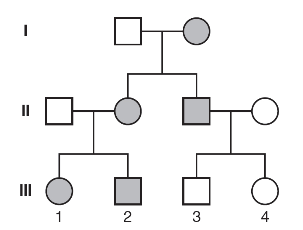
9. Based on this pedigree, which of the following most likely describes the inheritance of this trait?
(A) autosomal dominant
(B) autosomal recessive
(C) sex-linked recessive
(D) mitochondrial inheritance
10. If individual III-3 has a child with a woman who does not have the allele, what is the most likely probability that their child will have the trait?
(A) 0%
(B) 25%
(C) 50%
(D) 100%
Short Free-Response
11. Hemophilia is a sex-linked recessive disorder on the X chromosome. The following figure shows a portion of a pedigree of the descendants of Queen Victoria of England. Individuals with hemophilia are indicated by shading.
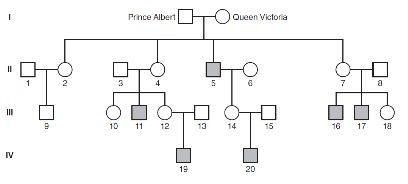
(a) Describe the genotype of individual 4 in generation II. Justify your answer with evidence from the pedigree.
(b) What is the genotype of individual 14 in generation III? Explain how you know her genotype.
(c) Create a Punnett square that represents the possible genotypes of the offspring of individuals 7 and 8 in generation II.
(d) Explain why the offspring of two closely related individuals are more likely to express recessive traits.
12. This pedigree shows the inheritance of a trait in three generations of a family.
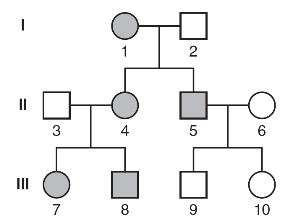
(a) Describe a likely mode of inheritance of this trait. Use evidence from the pedigree to justify your answer.
(b) Explain how a pedigree for a trait that is recessive would look different from a pedigree for a trait that is dominant.
(c) A student makes a claim that this pedigree indicates the trait is inherited through mitochondrial DNA. Evaluate this claim using evidence from the pedigree.
(d) Explain why the pattern of inheritance of an autosomal dominant trait is different from the pattern of inheritance of a mitochondrial trait.
Long Free-Response
13. In Drosophila (fruit flies), eye color is on the X chromosome. Male flies have an X and a Y chromosome, and female flies have two X chromosomes.
(a) A red-eyed male fly is mated with a white-eyed female fly. All the resulting female offspring have red eyes, and all the resulting male offspring have white eyes. Explain which trait, red eyes or white eyes, is dominant and why. Draw a Punnett square to support your answer.
(b) Scientists have discovered that white-eyed flies have a mutation in the enzyme TRY 2,3-dioxygenase (TDO2). TDO2 mutations prevent the accumulation of kynurenine, a compound associated with aging. White-eyed flies and red-eyed flies were raised under identical conditions, and the mean life span of both type of flies was recorded. Identify the independent variable and the dependent variable in that experiment.
(c) The data from the experiment described in part (b) are shown in the following table.

*Standard Error of the Mean
Evaluate the data to determine whether or not there is likely a statistically significant difference in the life spans of white-eyed and red-eyed flies based on this experiment.
(d) A nondisjunction event in meiosis leads to the production of a heterozygous red-eyed male fly with two X chromosomes and one Y chromosome. Predict the possible offspring from a mating between this male and a white-eyed female, and justify your answer.




